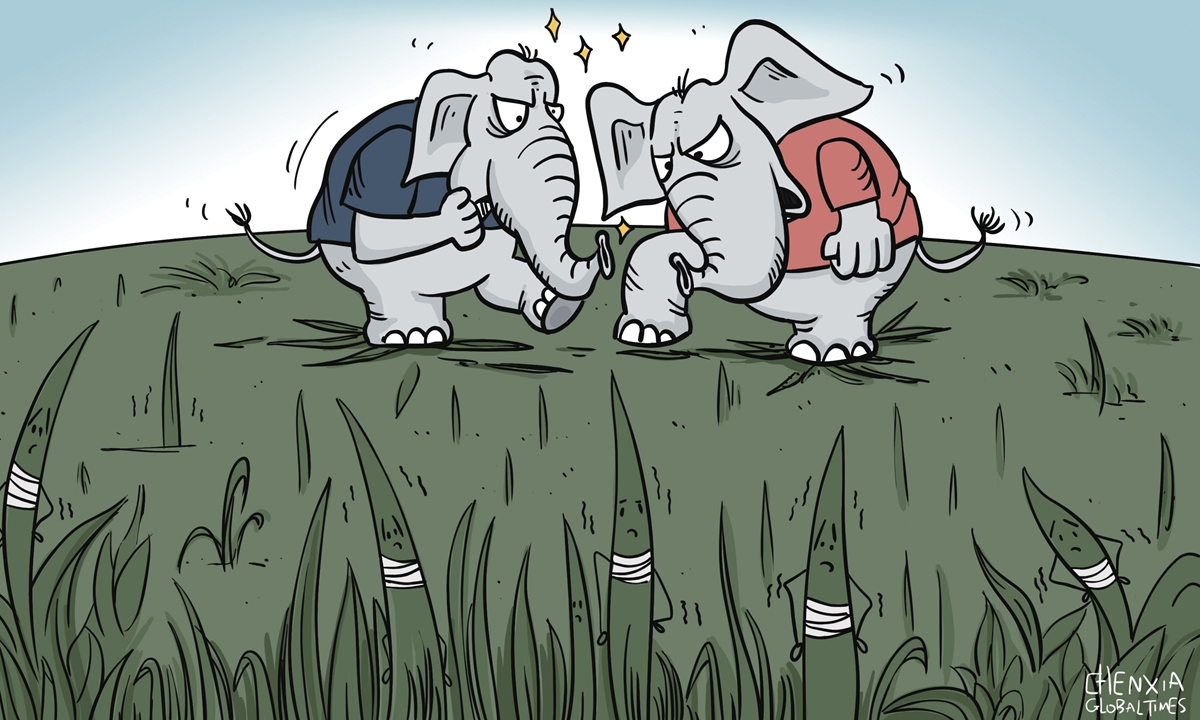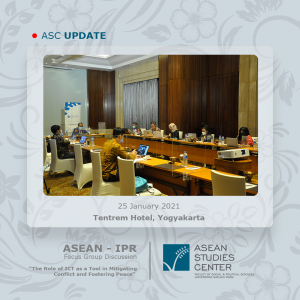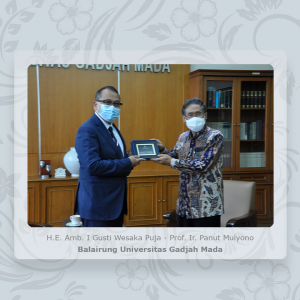AUKUS Impact for Achieving ASEAN Vision 2025
Written by: Hastian Akbar Stiarso & Rayhan Fasya Firdausi
The newly formed trilateral security partnership between Australia, the UK, and the United States (AUKUS) on 16 September 2022 is a contentious issue across the Indo-Pacific and beyond. The planned purchase of nuclear-powered submarines increases Australia’s naval deterrent capability against China’s growing naval power (Pillai Rajagopalan, 2021). It is feared that this will threaten the politics and security of the ASEAN region because although AUKUS is known to be not an alliance, it is a sign that has shocked the strategic landscape of ASEAN.
ASEAN welcomes the right kind of open competition among the great powers in the region—namely, peaceful and progressive. So far, ASEAN does not have a consensus with AUKUS. This is also why ASEAN member countries have mixed reactions to AUKUS. Indonesia is very wary of this development. Indonesia is “deeply concerned about the ongoing arms race and power projection in the region”. Like Indonesia, Malaysia is also concerned about whether AUKUS could trigger a regional arms race. Although Australia will not acquire nuclear weapons under the treaty, Malaysia remains concerned that transferring nuclear technology to an Australian submarine force could be a weak link in the nuclear weapons (Djalal, 2021).
Meanwhile, Singapore, Vietnam, and the Philippines remain neutral. They believe that AUKUS will strengthen regional peace and security. AUKUS is seen as a welcome step toward strategic balance in the regional geostrategic competition (Djalal, 2021).
The AUKUS issue should be a mutual concern of ASEAN member countries. This difference of opinion can be resolved if we adhere to the principles of the political-security pillar in ASEAN 2025, one of which is enhanced dialogue and cooperation with ASEAN external partners for mutual benefits and interests. This has also never been studied in previous studies.
AUKUS is a defense pact formed by Australia, Britain, and the United States on 15 September 2021. This defense pact was formed as a forum to share knowledge about advanced defense and to facilitate Australian troops with nuclear-powered submarines. The existence of AUKUS caused various reactions, including France, which opposed this partnership because it impacted their partnership with Australia. ASEAN countries themselves have different views on the existence of AUKUS. Malaysia and Indonesia reject the existence of AUKUS because they think that AUKUS will provoke other powers to be more aggressive in the region, specifically in the South China Sea. Singapore has a different view from Malaysia and Indonesia. They view AUKUS as contributing to building regional stability and peace. Vietnam chooses to act more cautiously. They choose not to comment on this issue (Southgate, 2021). Differences in views between countries impact efforts to maintain balance with the United States and China. The presence of AUKUS has an impact on the difficulty of achieving the status quo. These conditions, plus the entry of Australia to become more influential in the Indo-Pacific. ASEAN itself does not have a single voice on regional security issues. Therefore, ASEAN’s centrality will continue to face the influence of outside forces.
AUKUS is an essential issue for ASEAN, considering that they have the principle of centrality, where ASEAN is a key player in decision-making and the region’s future. While there has been a low level of concern over the struggle for power in this region, challenges to the principle of centrality are almost non-existent. However, China’s aggressiveness towards ASEAN countries caused this balance of power to be disturbed. In addition, the proliferation of non-ASEAN-centric cooperation, such as QUAD, whose members are DPs of ASEAN and members of the EAS, is a concern for ASEAN. With the advent of AUKUS, a partnership that is not ASEAN-centric in the region is added. The presence of AUKUS is seen as a geopolitical threat to ASEAN. This is related to the aim of AUKUS to counter increasing Chinese activities. Here there is a difference between QUAD and AUKUS. At the 2nd QUAD Summit, they convinced ASEAN that the existence of QUAD could reach ASEAN in practical terms. However, AUKUS has a different mindset; they have ideas about regional powers that interfere with ASEAN’s centrality. Therefore, the existence of AUKUS will cripple ASEAN’s strategic position (Gurjit Singh, 2021).
AUKUS will bring ASEAN into a security dilemma where the procurement of nuclear submarines for Australia will bring a new chapter in the arms race in the region. On the other hand, ASEAN adopts the principle of balance of power in ensuring regional security. The presence of AUKUS as a new force will impact the distribution of power in the region. The condition of security integration in ASEAN itself is still low, so a joint defense strategy is far from being formed. ASEAN seeks to form a unified and inclusive community in the defense field through the ASEAN Community 2025. The ASEAN Community 2025 views ASEAN as a united and inclusive community and a resilient society. Our society will live in a safe, harmonious, and secure environment, embracing the values of tolerance and moderation as well as upholding ASEAN’s basic principles, shared values , and norms. ASEAN must remain cohesive, responsive, and relevant in addressing regional peace and security challenges and play a central role in shaping the regional architecture while deepening our engagement with external parties and contributing collectively to global peace, security, and stability. However, to achieve that, ASEAN itself is difficult to have one voice, and AUKUS plays a role in showing that there is no cohesion among member countries. AUKUS will increase regional power competition, creating the potential risk of arms races and significant power confrontations, further weakening regional prosperity, peace, and stability. However, AUKUS can also be a tool to trigger ASEAN to maintain regional order by promoting dialogue. This can be seen in ASEAN’s efforts to build an ASEAN-centric platform for security dialogue, such as the ASEAN Regional Forum.
There has never been an issue like AUKUS in ASEAN before. The closest issue is the establishment of SEATO in 1954, which involved the Philippines and Thailand before becoming part of ASEAN. So this AUKUS issue must be faced without any examples from the past. AUKUS issues can be handled easily if ASEAN and AUKUS emphasize the dialogue function. As stated in ASEAN Vision 2025, dialogue and cooperation with ASEAN external partners must be increased to achieve mutual benefits and interests. Before reaching ASEAN’s external partners, we must improve dialogue within ASEAN’s internal. We can see that within ASEAN, there are still differences of opinion among ASEAN countries, such as Indonesia and Malaysia, which have different views from Singapore, Vietnam, and the Philippines in responding to the existence of AUKUS. With this dialogue, ASEAN member countries can have the same attitude in dealing with the AUKUS issue.
Furthermore, dialogue can also be increased by presenting AUKUS as an external partner of ASEAN. In this dialogue, it can be discussed the possibilities that can occur in the cooperation of Australia, Britain, and the United States, which can affect the security of the ASEAN region. This dialogue is expected to produce beneficial cooperation for both parties while helping ASEAN achieve ASEAN Vision 2025 in the pillars of security politics.
About Writers:
- Hastian Akbar Stiarso is an undergraduate student majoring in International Relations at UPN “Veteran” Yogyakarta. Hastian is a member of KSM DEFENSIA, a study group engaged in traditional and non-traditional security studies. Hastian has an interest in security studies, especially in traditional security and conflict management. 151190057@student.upnyk.ac.id
- Rayhan Fasya Firdausi is an undergraduate student majoring in International Relations at UPN “Veteran” Yogyakarta. Rayhan is a member of KSM IRON FIRE, a study group engaged in research and writing for security studies. Rayhan has interests in non-traditional security studies, conflict resolution, and social movements. 151190101@student.upnyk.ac.id
Bibliography
- Djalal, D. P. (2021). Asian review: Diplomatic caution: ASEAN responses to AUKUS security dynamic. East Asia Forum Quarterly, 13(4), 16–18. Retrieved from https://search.informit.org/doi/abs/10.3316/informit.191261782401741
- Gurjit Singh. (2021). The ASEAN disunity over AUKUS. Retrieved 5 September, 2022, from ORF website: https://www.orfonline.org/expert-speak/the-asean-disunity-over-aukus/
- Pillai Rajagopalan, R. (2021). Does AUKUS Augment or Diminish the Quad? Retrieved 5 September, 2022, from ORF website: https://www.orfonline.org/research/does-aukus-augment-or-diminish-the-quad/
- Southgate, L. (2021). AUKUS: The View from ASEAN. Retrieved 5 September, 2022, from The Diplomat website: https://thediplomat.com/2021/09/aukus-the-view-from-asean/







 “Standing on the Edge of a Thorn” is an intimate portrait of a family in rural Indonesia grappling with poverty, mental illness, and participation in the sex trade. The movie has succeeded in portraying how gender violence issues happened. During the discussion, Dr. Robert Lemelson, Ph. D has highlighted that this movie has brought up the issue of gender violence, which was previously considered a taboo subject to be discussed by the public. Even though the problem is happening a lot and affects the psychology of other family members, it is still considered taboo to bring up this issue. Ninik Supartini, M. Si. has also stated her efforts to approach people to recognize gender violence. According to her, gender violence is a structural issue and requires a prolonged approach to resolve it. Indiana Puspa Dewi, S.S., MA, a Ph.D., has also stated the importance of maximizing the village’s cultural background and situation to handle cases of gender violence in the community. The discussion also became more interesting with the Q&A session with participants of this movie screening.
“Standing on the Edge of a Thorn” is an intimate portrait of a family in rural Indonesia grappling with poverty, mental illness, and participation in the sex trade. The movie has succeeded in portraying how gender violence issues happened. During the discussion, Dr. Robert Lemelson, Ph. D has highlighted that this movie has brought up the issue of gender violence, which was previously considered a taboo subject to be discussed by the public. Even though the problem is happening a lot and affects the psychology of other family members, it is still considered taboo to bring up this issue. Ninik Supartini, M. Si. has also stated her efforts to approach people to recognize gender violence. According to her, gender violence is a structural issue and requires a prolonged approach to resolve it. Indiana Puspa Dewi, S.S., MA, a Ph.D., has also stated the importance of maximizing the village’s cultural background and situation to handle cases of gender violence in the community. The discussion also became more interesting with the Q&A session with participants of this movie screening.







